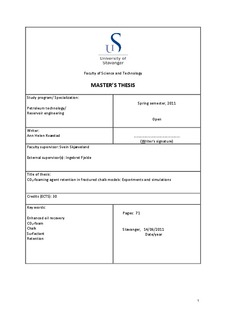| dc.contributor.author | Kvæstad, Ann Helen | |
| dc.date.accessioned | 2011-10-28T12:11:08Z | |
| dc.date.available | 2011-10-28T12:11:08Z | |
| dc.date.issued | 2011 | |
| dc.identifier.uri | http://hdl.handle.net/11250/183319 | |
| dc.description | Master's thesis in Petroleum engineering | no_NO |
| dc.description.abstract | Injection of CO2-gas can improve the oil recovery. In naturally fractured reservoirs such as chalk, injection of CO2-gas can result in early gas breakthrough because the gas can use the fractures as pathways from the injector to the producer. The pressure, temperature and oil properties in the reservoir can also lead to an unfavorable mobility for the gas. This can lead to low total sweep efficiency for the process. One method to increase the total sweep efficiency in the fractured reservoir is to use CO2-foam. Foam has a higher apparent viscosity compared with gas alone, and this can increase the resistance to flow, thus the CO2-mobility can be decreased. Retention of the foaming agent in the reservoir can cause instability of the foam. This can lead to foam collapse and the process can become more expensive because of the extra foaming agent that has to be injected.
In this thesis the retention and transport of the foam forming agent in fractured chalk models have been investigated in experiments and mechanistic simulations. This was performed at 100 % water saturation (Sw = 100 %) or residual oil saturation after water flooding (Sorw). Different surface area of the core plugs where blocked and was not exposed to the foaming agent solution. The objective was to see how the different designs would affect the retention and transport. In the modeling studies a reservoir simulator, STARS, from Computer Modeling Group (CMG) was used.
Experimental results show that transport of the foaming agent would depend on the design of the fractured model. It was also seen that the rate of retention increased with increasing surface area exposed. In this thesis Sorw did not have a significant effect on the retention of the selected foaming agent in the fractured model. In the simulations the concentration of the foaming agent in the fracture vs. time for core plugs at 100 % water saturation with all surface area exposed was history-matched. The same data set was used to predict the concentration of the foaming agent in the fracture for the other designs at 100 % water saturation. Further work with the foaming agent used in this thesis should be performed. | no_NO |
| dc.language.iso | eng | no_NO |
| dc.publisher | University of Stavanger, Norway | no_NO |
| dc.relation.ispartofseries | Masteroppgave/UIS-TN-IPT/2011; | |
| dc.subject | petroleumsteknologi | no_NO |
| dc.subject | reservoarteknologi | no_NO |
| dc.subject | enhanced oil recovery | no_NO |
| dc.subject | CO2-foam | no_NO |
| dc.subject | chalk | no_NO |
| dc.subject | surfactant | no_NO |
| dc.subject | retention | no_NO |
| dc.title | CO2-foaming agent retention in fractured chalk models: Experiments and simulations | no_NO |
| dc.type | Master thesis | no_NO |
| dc.subject.nsi | VDP::Technology: 500::Rock and petroleum disciplines: 510::Petroleum engineering: 512 | no_NO |
